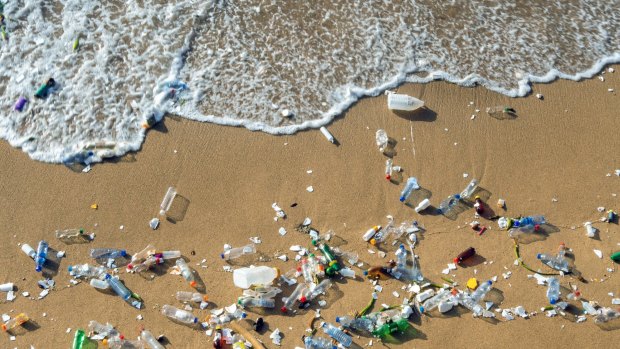This was published 1 year ago
Plastic pollution in oceans: What can travellers do about it?
By Lee Tulloch

About 12 million tonnes of plastic pieces flood into the world's oceans annually.Credit: iStock
We might get the idyllic beach summer we've been dreaming of this year, but there's something more frightening than sharks and jellyfish in the water.
Plastic.
A lot of plastic. About 12 million tonnes of plastic pieces flood into the world's oceans annually and it's estimated that another 1.3 billion tonnes will swamp the oceans in the next two decades. At current rates, that plastic is expected to outweigh all the fish in the sea by 2040.
Of great danger to sea life are all the nets, fishing lines, ropes and hooks that are lost to sea, mostly from smaller fishing trawlers and boats. The CSIRO estimates that lost lines would stretch around the earth eighteen times. Fishing nets effectively keep scooping up fish even when they're lost or discarded, tangling and trapping sea life and birds, large and small.
It's not just the nets, polystyrene, plastic bags, bottles, straws and packaging materials either. Micro plastics less than 5mm are as big a threat, moving through the food chain, the toxins ingested by sea life and in turn ingested by us. Micro plastics are close to invisible and are impossible to be collected on beach clean-ups like a discarded fast-food container might be.
It gets worse. Microplastics were found in the blood of 80 per cent of people tested in a small Dutch research project. We don't know yet the effect on the body's organs or whether they stay in our blood stream.
It should come as no surprise to anyone who has travelled in coastal regions of Asia, specifically Indonesia, China, the Philippines, Vietnam and Thailand, that almost 81 per cent of plastic in the world's oceans comes from Asia.
When I was last in Vietnam, the rocks along the coast were a collection point for packaging from local markets, and general household waste. It was a blight on the environment, even more so for the fact that no one seemed interested in doing anything about it.
I am swamped by plastic in my own life. There's so much of it, from the pens I write with to the plastic tray my Iced Vovos come in.
The beauty and pharmaceutical industries are the worst culprits. From toothpaste to plastic bottles and unnecessary packaging to market beauty products, this industry has been profligate and continues to be. I go through my bathroom shelves and it's a tsunami of plastic. Even drugs come in plastic blister packs.
Small personal solutions to rid myself of single use plastic - using shampoo soaps, toothpaste tablets, reusable coffee cups, waxed cloths - seem so futile. I always carry string bags with me when I shop, and I avoid buying things online because they invariably come with an excessive amount of packaging. But there are few realistic alternatives to household goods sold in plastic that isn't recycled.
People trying to do the right thing have been let down by corporations and governments. The recent REDcycle debacle with the collapse of soft plastic recycling through supermarkets creates a huge lack of trust in recycling systems.
It's so bad that you'd think we'd be doing everything we could as a society to curtail plastic manufacturing and use, but the fossil fuel industry plans to increase plastic production by 40 per cent in the next decade. Of course they do.
In the travel industry, airlines, cruise lines and large hotel groups are finally reducing their plastic, although change has been a bit glacial. It's speeding up now, not so much due to complaints from conscientious travellers but to hard economic sense - corporations increasingly demand green certifications from hotels to satisfy their own environmental benchmarks.
Hotel plastic is only a fraction of the problem, though. I'm in Cambodia now and, like its neighbour Vietnam, the countryside is a plastic waste dump, leaching into the Mekong and to the sea.
Often, it's left to charities, small tourism operators and NGOs to try to stem the tide. What can concerned travellers do about it? Our best effort is to support worthwhile organisations such as the Pure Ocean Fund, Plastic Oceans and the Surfrider Foundation, as well as the local operators we come across on our travels which are working valiantly on ocean clean-ups or projects like mangrove rehabilitation.
In good news, Australia has just joined a coalition of 20 nations that hopes to end plastic pollution by 2040, with binding targets to phase out plastic waste products by 2025.
It needs to work because we're all drowning.
lee.tulloch@traveller.com.au
Sign up for the Traveller newsletter
The latest travel news, tips and inspiration delivered to your inbox. Sign up now.